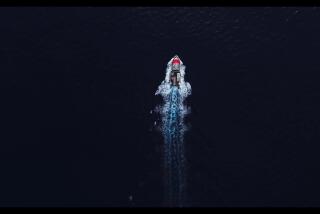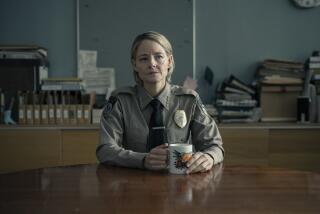Navigating a Sea of Adventure : Author Uses Contemporary Voice to Relate Novel’s Tale of Arctic Explorers
As a child growing up on Massachusetts’ Cape Cod, Andrea Barrett was mesmerized by the memoirs of 19th century arctic explorers, with their tales of adventurous sea voyages through ice-choked passages, disastrous shipwrecks and “wintering over” on the killing ice pack.
Time slowly eroded the details of those stories from her memory, though, as Barrett grew up and stepped into adult life. College. Marriage. Dislocation from Cape Cod to western Massachusetts then to Rochester, N.Y., where she slipped into daily clouds of solitude to focus on her own writing, her own tales of personal, rather than polar, exploration.
Yet it was fiction writing that brought the details of those old explorers’ tales rushing back in a flood tide. A few years ago, Barrett was researching her 1996 National Book Award-winning collection of fiction, “Ship Fever” (Norton), the title story exploring the harsh welcome Canadians gave to disease-ridden Irish immigrants fleeing the potato famine in 1845-48.
“[The stories] popped up again partly as a result of reading about Irish immigrant ships that had left late in the season and been sunk by ice floes from Baffin Bay,” Barrett says by telephone from her home in Rochester. “A minor character from ‘Ship Fever,’ Ned Kynd, disappears from the [story]. I had wanted to write more about him than I could in the novella, without spoiling that story.”
The result is “The Voyage of the Narwhal,” a novel about the very real efforts to find the lost expedition of Sir John Franklin, in which 129 men perished in the 1840s while searching out the Northwest Passage across northern Canada.
It’s an intriguing novel, reflecting the realism that dominated 19th century fiction yet told in a purely contemporary voice and in cinematic detail. It would work wonderfully as a movie, in fact, with its mix of romance and adventure and its reclamation of a forgotten past.
While the moving force of the plot is the attempt to find Franklin’s expedition, and the secret plan by expedition leader Zechariah “Zeke” Voorhees to explore the Polar Sea, Barrett focuses most of her writing on the relationships among her characters as they struggle with guilt and recriminations, loyalty and the bond of family.
*
As it turns out, Ned Kynd, in Barrett’s hands a classic survivor, becomes relegated to minor status once again, serving as ship’s cook, while Erasmus Darwin Wells, a frustrated naturalist, and Zeke take over the story.
The two men are bound by history, and family. As a boy, Zeke spent much of his time at the Wells home, hearing tales of adventures and explorations related by Erasmus’ father, an avid naturalist and publisher. As a man, Zeke becomes engaged to Lavinia, the sister of Erasmus, himself a star-crossed naturalist whose one shot at fame dissolved in the aftermath of a disastrous trip.
Zeke, driven by the egocentric need to have his name etched on maps, enlists Erasmus to help with his journey ostensibly to find Franklin. Once they’re at sea, though, Erasmus begins to understand Zeke--thoroughly dislikable in his arrogant incompetence--in ways that he never had before.
“Their relationship is everything, and I really didn’t understand that when I started the book,” Barrett says. “I think for them to be such firm antagonists, and for me to bring Zeke to life as somebody real important to Erasmus, someone he had to push against, really shaped the book more than I understood when I started.”
There’s much more to the book, though. Barrett also explores what has become a familiar topic for her--the difficult history of women and science. It hints at her own torn impulses.
“These are two things I really love--writing and science,” says Barrett, whose husband teaches biophysics at the University of Rochester. “I have wanted to be a scientist, and I studied science when I was young. I’m married to a scientist. A lot of my friends are scientists. People other than me would have figured out long ago that it was a natural subject matter for my fiction.
“I didn’t see that. It took me so long to learn to write, to just get the basics of fiction under my belt, that I was correspondingly slow to see that the thing I wanted to use those techniques for was the history of science.”
Her first novel, “Lucid Stars” (Dell, 1988), uses astronomy as a touchstone, almost a language of reconciliation, between the mother and daughter whose troubled relationship lies at the center of the book. “Ship Fever” expands the theme to the frustrations of intelligent and curious women relegated to the scientific sidelines during the 1800s--a time when the natural sciences, from theories of evolution to cataloging, were coming alive. Charles Darwin had already made his famous voyage on the Beagle, but his “Origins of the Species” wouldn’t be published until 1859.
In “The Voyage of the Narwhal,” Barrett’s sixth book, the theme flowers in the form of Alexandra Copeland. Hired as a companion for Lavinia in Philadelphia while her brother and fiance sail north--a trip that covers roughly the first two-thirds of the book--Alexandra yearns for the adventures and experiences Erasmus pursues.
“If Alexandra lived now, she would be cruising the Arctic by herself, or going into space,” Barrett says. “But those were not options available to a woman like her then.”
There were women explorers, Barrett says, but they hailed mostly from wealthy families in which the men set the tone as explorers and scientists. Most women were shut off from that life, as they were from most other possible outlets for creativity, imagination and ambition.
*
Barrett writes with a voice of quiet confidence, the payoff of diligent research that brought her back in touch with those old explorers’ tales from her youth. Ersatz travelogues, the books--including some by Franklin before his ill-fated final voyage--were public renderings of explorers’ diaries.
Though the authors are little known to us now, the books were the publishing rage of the time, some of them selling hundreds of thousands of copies and helping define for the unadventurous the outer limits of a world they could barely imagine.
But rereading those old adventure stories wasn’t enough for Barrett. She spent two weeks last summer camping at the edge of the ice pack on the north shore of Baffin Island, seeing for herself what the explorers had seen, and trying to capture the natural scenery in sketches, as did the naturalists of the 1850s.
“I had done about six drafts of the novel by then and had two more to go,” Barrett says. “I went thinking I knew what it looked like, after all that reading, and I would just be confirming. But I was wrong about tons of things. It was just a remarkable landscape.”
The experience helped her write in striking detail about the physicality of the place.
“The wind grew fierce again,” Barrett writes, describing efforts by the crew of the Narwhal to cut a safe docking space on the leeward side of “land-fast” ice as a gale strengthened around them. “Above them a glacier poured between two cliffs crowded with nesting murres: black rock streaked with streams of droppings; the clean white river of ice; more soiled rock secreting waves of ammonia and an astonishing squawking noise.”
The visit also firmed Barrett’s descriptions of efforts by Erasmus, Alexandra and Erasmus’ brother, Copernicus, a landscape painter, to capture the Arctic using Erasmus’ sketches and memory.
“When I first wrote those parts of the book, they meant one thing,” Barrett says. “After I tried to do it myself, it meant a whole lot of other things. I was able to get a clear sense of what Erasmus was struggling to describe in words, just trying to wrestle with something that is bigger than yourself, that is hard to describe, and combined people in this shared effort.”
Barrett’s not ready to leave that era yet. Nor, for that matter, is she done with Ned Kynd, the bit character now in two of her works.
Barrett’s in the early stages of a story that follows Kynd to the lumber camps of the Adirondacks in the 1850s, where Barrett has left him at the end of “The Voyage of the Narwhal.”
“I don’t know where I’m going with it,” Barrett says. “The more I learn about [that era], the more I get drawn into it. Everything was happening. Everybody was learning about everything, and everything was being named. Evolution was in the air. Ideas of geology, embryology, all of science was coming together in just this huge radiating intense explosion.
“But the world of science was still small enough that people could be involved in a lot of different fields, in ways that they can’t anymore. That really was the last time you could be a naturalist in the largest sense.”
As Barrett talks, it becomes clear that she’s likely going to leave Ned Kynd behind again, consigning him, Zelig-like, to be a recurring sacrifice to her compelling art of science.
More to Read
Sign up for our Book Club newsletter
Get the latest news, events and more from the Los Angeles Times Book Club, and help us get L.A. reading and talking.
You may occasionally receive promotional content from the Los Angeles Times.









